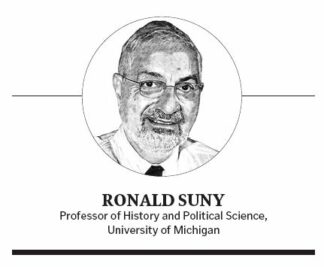
Opinion: Evolving new world order

Finland’s entry into NATO marks the possible end of Finlandization – a model of neutrality and accommodation
Published Date – 12:45 AM, Fri – 7 Apr 23

by Ronald Sunny
Hyderabad: In the world of geopolitics, great powers make, break and play by their own rules. Small states have to adjust to the world at large as determined by others.
That’s why judgment by Finland A country of just 5.5 million people, known for decades as a neutral presence in Europe – joining NATO is vital. It underscores how the Russian invasion of Ukraine subverts global realities, at least the thinking long held by Western powers.
The entrenched “rules-based order” that the United States and its NATO allies tout as the best way to run the world is changing—attracting some, yet no secret to club membership in the eyes of nations. . Meanwhile, Russia and China are disputing the hegemony of the US and the West over global affairs and are seeking a system in which power is distributed regionally, with Moscow and Beijing representing their respective parts of the world. Let’s see in form, dominate him.
Smaller nations around the world are recalculating how they fit into this new division of the world.
Finland is one such state and has made a dramatic choice. For centuries it has had to reckon with – and accommodate – its interests in its vast neighbours: Tsarist Russia, the erstwhile Soviet Union and today Vladimir Putin’s Russia. During the Cold War years, Finland adopted a model of neutrality and accommodation to co-exist with Russia. This method of dealing with a nearby great power was known as “Finlandization”.
with the invasion of russia ukraine A year ago, decision-makers in Helsinki hammered the final nail into the coffin of Finlandisation. The concern for Putin – and perhaps the West – is that the model has not only been killed for Finland; It’s also dead set as a possible off-ramp solution to the conflict in Ukraine.
protection of liberty
After more than a hundred years within the Tsarist Empire, Finland gained its independence in 1917. For the next nearly 20 years it became an anti-Soviet outpost next to the Soviet Union. Soviet dictator Joseph Stalin saw Finland as a gateway for enemies of the communist state. In his mind, Finland was an existential threat – as Putin views Ukraine today.
Having annexed eastern Poland and the Baltic states—Estonia, Latvia, and Lithuania—after the signing of the German-Soviet Pact of 1939, Stalin demanded serious territorial concessions from Finland. The resulting war saw the Finns lose their eastern provinces, but they managed to retain their independence – at some cost. Finlandization was the price of maintaining its democratic state and capitalist economy in domestic affairs during the Cold War.
Through a model adapted to neutrality, Finland was able to convince Moscow for more than half a century that it was not a threat but a loyal trading partner. With the collapse of the Soviet Union in 1991, skepticism about Finland increased among Finns. They debated whether they should consider joining the Western Alliance.
But it was Putin’s invasion of Ukraine in 2022 that tipped the scales and finally convinced Helsinki that becoming a NATO member would enhance its security.
neutrality dilemma
The invasion also killed any idea of Finland as a model for post-Soviet Ukraine. For the past 30 years, independent Ukraine was seen as a problem for Putin, who feared its gravitation towards the West. Similarly, even before the invasion last year, Russia There was a problem for Ukraine, with the authorities in Kiev fearing dominance from the east.
Prior to the current war, the Finnish model of independence and neutrality was seen as a viable alternative to Ukraine joining NATO or moving closer to the Russian-led strategic alliance, the Collective Security Treaty Organization.
Finland’s experience of preserving its sovereignty by compromising its right to act completely independently in foreign policy could be a viable model for former Soviet states, some observers held, particularly with regard to Ukraine. . Findlandisation could also happen, so the thinking went, providing a solution to Ukraine’s internal divisions over the question of whose side to take: the West or Russia.
During the 1990s and 2000s, Ukraine oscillated between a pro-Russian orientation in eastern Ukraine, and a more pro-Ukrainian nationalist identity becoming powerfully evident in western Ukraine. Finlandization of Ukraine, combined with the federalization of Ukraine’s various provinces, could reduce political polarization with Ukraine and fear of Russians and Putin in particular.
Of course, history cannot be rewritten; Such alternative possibilities cannot be tested. And federalism, which would require that some decision-making be delegated to regional governments, was considered questionable as a viable form of state by many in Ukraine and Russia alike. A similar process of federalization was ultimately blamed for the breakup of the Soviet Union.
Furthermore, events forced Ukraine’s hand. As Russia drifted towards authoritarianism and used its oil and gas as a weapon against Ukraine, the allure of the West – democracy, prosperity and a gleaming modernity – seemed ever more enticing.
At the initiative of the United States, the West ambiguously promised Ukraine NATO membership, which Russia found completely unacceptable. And the European Union offered closer economic and political ties to Ukraine, prompting fears in Moscow that it was the first step toward NATO. After the Russian annexation of Crimea in 2014, Ukrainians turned even more westward and became more receptive to Western promises of NATO membership.
small nation
Finally, there was hope that Ukraine could be ‘Finlandised’ or federated, both of which were victims of Putin’s increasingly hard line towards Ukraine. enter finland NATO Finlandisation marks the likely end of the model. Even Finland has abandoned it; Neutral Sweden is now eager to join the Western Alliance; And other states, even Switzerland, are questioning the efficacy of non-alignment in a polarized world.
In its place, we have the “NATOfication” of Eastern Europe – something that Putin inadvertently accelerated and that leaves Putin’s Russia with less friendly neighbors. Meanwhile, countries like Finland and Sweden are left with fewer options. “A small nation can disappear,” Czech writer Milan Kundera reminds us, “and knows it.
theconversation.com

